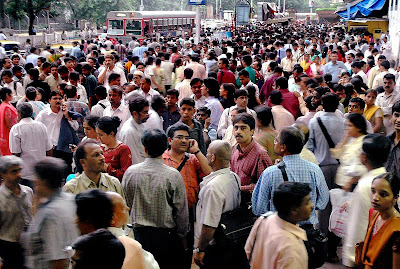Mumbai transport constitutes of thousands of citizens moving around the city by road, rail, air and water. These form an essential part of a massive network of transport.
The first bus in Bombay ran on July 15, 1926. Though it was received with great expectations and enthusiasm, this form of transport was yet to become available for all classes of society. For several years, it was looked upon as transport that was solely meant for the higher sections of society. The preferred mode of transport for the poorer classes was the tram. The bus fare was considerably higher than that of the tram. The bus fare would exceed the tram fare by a large margin.
Imagine how difficult it would be to transport THIS humungous crowd to wherever they want to go , and on time!

PS
Look at how almost all the people stare at the camera or the really hot indian woman taking the picture :) Indian mentality you could say :)
Different forms of transport in Mumbai include:
-Bus Service: The bus service provided in Mumbai is the main mode of transport. Most commuters take the public buses to and back from work. The buses have routes all over Mumbai. There is a mad rush to board the buses as they drive into the stops. People run to get on the bus. The entry to the buses is mandatory through the rear entrance. People can dismount from the bus through the front door. The buses have signboards that give details of where the bus stops and these details are displayed clearly. The bus service is of vital importance to the citizens of Mumbai.
-Railways: The Mumbai Railway system is owned by Indian Railways and is operated by Western Railways and Central Railways. With an overall length of 303 km, it claims to have the highest passenger density in the world, six million people every day. The railways are the best choice for anyone with a long commute route. These rail lines connect several parts of Mumbai. The rail service offers local trains and express trains. The local trains run through the usual routes with a stop at every station. The express trains run at higher speeds while skipping stops to reach the final destination.
-Taxis: The taxis arrived in Mumbai as a more personalized alternative to public transport. The taxis are painted black and yellow. The amount of fare is decided by the meter which measures price based on distance traversed. They are preferred by tourists and for long distance journeys through Mumbai. The cost of the taxi is slightly expensive but it provides privacy and comfort.
- Auto Rickshaws: Auto rickshaws play an imperative role of public transport in Mumbai. Auto Rickshaws are the most common mode of public transport for family outings and transport to specific parts of Mumbai. They are costlier than buses but more affordable than taxis. Most of these Auto Rickshaws are run for the public. Some Auto Rickshaws are privately owned and only transport the preset people. Some of these Auto Rickshaws are modernized and have air conditioning to keep you cool in the heat. The standard of Auto Rickshaws is improving by the day.
Cheers,
The Techmechanic!!
Mumbai Transport, Mumbai travel, Mumbai travel tips

No comments:
Post a Comment